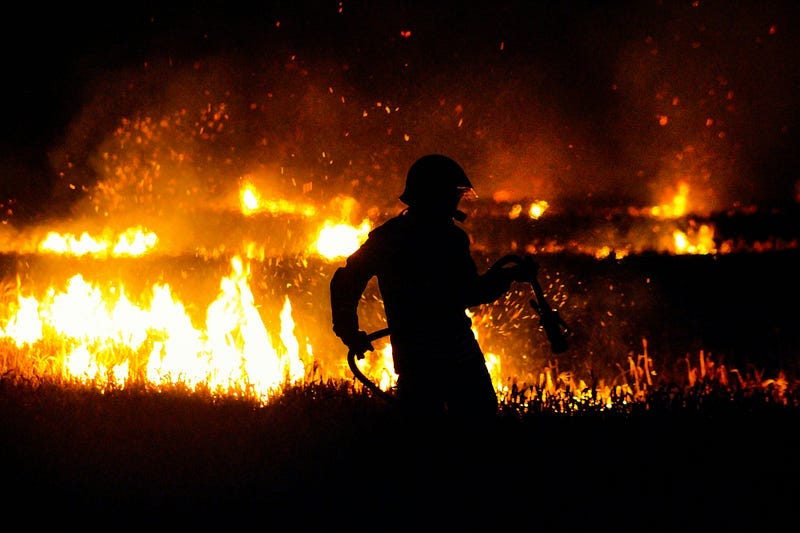The Arctic Is On Fire
This is deeply worrying.

The Arctic is more than just ice sheets. The giant Boreal Forest takes up 17% of the land mass north of the Arctic Circle. This otherworldly frozen forest provides the world with 21% of its oxygen, and over the past few weeks, 160 wildfires have devastated the region, damaging 460,000 hectares of forest. In the past, wildfires were a rarity in the Boreal, as its frigid temperatures and abundant ice quench any spark instantly. But the hotter, dryer weather of recent years has rendered this majestic environment into kindling. These recent fires are so destructive that over the month of June, they pumped 6.8 million tonnes of planet-wrecking carbon into the atmosphere. But that isn’t why Prof Guillermo Rein, Professor of Fire Science, Imperial College London, told the BBC that these fires are the “growing monster of climate change”.
Let’s start with why the Boreal is beginning to experience regular wildfires. In short, it is caused by Arctic Amplification.
You see, the Arctic is warming twice as fast as the rest of the planet. This is partially due to its changing albedo, or how much Sunlight the environment reflects. When the Arctic is covered in snow and ice, most of the Sun’s light is reflected into space. But higher temperatures mean less ice and snow, which makes the land less reflective. This means it absorbs more of the light’s energy, warming up the terrain. As the terrain gets hotter, it emits this heat through infrared light. Atmospheric carbon dioxide is incredibly good at absorbing this light, and as such, the infrared light from the terrain heats up the atmosphere rather than escaping to space. This, in turn, heats up the Arctic, which means less ice and snow, more light energy trapped in the atmosphere and so on. This feedback loop significantly amplifies climate change at the poles. But, it can only account for around 45% of the Arctic’s warming. The rest is produced by convection, where the cold, dense sinking air of the Arctic draws in hot, dry and less dense air from the tropics in a similar way to how a sea breeze is generated. This significantly cools the tropics and pumps massive amounts of heat into the polar regions. But this convection gets stronger the hotter the tropics get, making the Arctic warm faster than the rest of the world.
So, that’s why the Boreal is now significantly warmer and dryer than it used to be and why wildfires, which would be a once-decade event, are now happening year after year and ravaging vast swathes of this delicate environment.
Now, while the 6.8 million tonnes of carbon the recent fires have released into the atmosphere is far from insignificant, these fires have two far more wide-ranging and potentially far more damaging side effects.
Firstly, the soot from these fires is settling on the snow and ice sheets further north of the forest. This, in turn, lowers the albedo of that environment and heats it up, exacerbating the albedo feedback loop already taking place. Not only does this mean more rapid heating of the Arctic and the loss of even more ice sheet, but it also means that the Arctic’s cooling effect on the Northern Hemisphere and tropics is reduced. As such, this soot can actually make extreme weather, such as heat domes and hurricanes, worse across the entire Northern Hemisphere.
Secondly, it makes the possibility of one of the most devastating climate tipping points more likely. The Boreal permafrost, the soil that stays permanently frozen all year round, contains 1,400 billion tonnes of carbon, or roughly twice that currently in the atmosphere. Much of this carbon is locked away as methane clathrate, a form of ice penetrated with methane. As such, if this permafrost store collapses, even by a small amount, a truly gargantuan amount of carbon emissions will be released. The warming from this will cause even more thawing and even more heating in a devastating feedback loop. Current estimates suggest this permafrost collapse could happen when global warming reaches 3 degrees Celsius, and once the feedback loop has run its course, push global warming up to 6 degrees Celsius! That might not sound like much, but it will be enough to push humanity to the brink.
These forest fires won’t cause this permafrost collapse. But they will strip back and severely damage the ecosystems that protect the permafrost. Forest cover and moss cover greatly insulate the permafrost from warmer weather, allowing them to survive extreme conditions. But, unlike many other forests, the Boreal ecosystem hasn’t evolved to recover and cope with extensive wildfires. As such, the areas deeply affected by these fires could take many decades to recover, leaving the permafrost beneath them vulnerable. As such, these Boreal forest fires make the permafrost collapse more likely.
So how do we stop this? Simple, rapidly decarbonise our society and protect these essential ecosystems and environments from climate change. We have the technology and ability to do this; it is not beyond our scope. We just have to choose the health of our planet and our species over upholding the status quo.
Thanks for reading! Content like this doesn’t happen without your support. So, if you want to see more like this, don’t forget to Subscribe and help get the word out by hitting the share button below.
Sources: Copernicus, BBC, BBC, Science Direct, Carbon Brief, Science Direct, NSIDC, NSIDC

